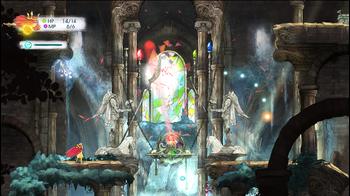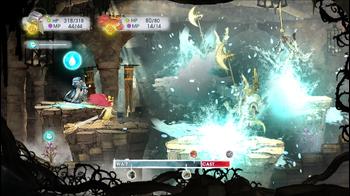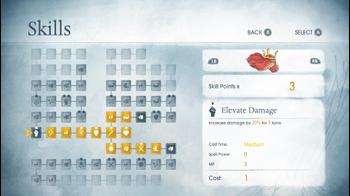
Child of Light Review
Child of Light is an interesting mix of ideas and concepts, and it’s hard to look at it without a sense of curiosity and wonder. It has been described as a sidescroller, but it doesn’t involve tricky jumps or high speeds. Child of Light is also said to have JRPG inspirations, but it’s a western developed take on that. A sidescrolling/JRPG hybrid resembling a fairy-tale with a poetic narrative? It’s definitely a title to be curious about. This title is the brainchild of a small team at Ubisoft Montreal utilizing the UbiArt framework used in the company’s Rayman titles. Often described as a playable poem, Child of Light is a beautiful, bite-sized, artistic title that offers something just a little bit different.
You play as Aurora, a young princess who mysteriously awakens in a dream world of the Kingdom of Lemuria. Accompanying this girl is a mysterious blue spark of a companion named Igniculus. Desperate to find her father, she sets out for adventure in this strange land. The presentation from the onset is enchanting and captivating, as though you are moving Aurora within a painting. Colors are vibrant without being ‘loud’ and stunning backdrops and foregrounds make Child of Light a visual pleasure. A poetic theme complements the painting style as the writing in Child of Light is delivered in rhyming ballad structure. All narration and conversations, including Aurora and Igniculus’ back-and-forths, are delivered in rhyme. While the poetic meter seemed to be a little inconsistent at times, the structure only accentuates the fantastical nature of the world of Lemuria. The music also is very whimsical, melancholic, and sometimes powerful. This culminates in a gorgeous and relaxing game, which is a pleasure to experience.
Exploration is a key component to the game. You move Aurora effortlessly through the environment as you look for what amounts to dozens of chests and stat-up items. Don’t get the wrong idea, although sidescrolling exploration is what you are spending most of your time doing outside of battle, the game is nothing like the Metroid/Castlevania style. This is much more relaxed and calming in nature. There are both wide open areas and more congested spaces, with these collectables scattered all about in nooks, high up in the air, or hidden around enemies, puzzles and traps. There are no random encounters in Child of Light; rather, you see every enemy within the environment and, upon touching them, are thrust into battle.
The battle system is best related to the one found in the Grandia series, and will sound familiar to veterans of that franchise. Each battle participant’s icon is placed on a timeline dictating the turn order. First, as time passes, the icon crosses the Wait section of the timeline until it hits the Cast marker. At this point time stops and you can choose whatever ability you need to perform. After you make your selection, the icon must travel the rest of the way to the end of the timeline before the action takes place.
Different actions have different cast speeds, and there are also abilities to affect how fast a character’s icon travels or where it starts each turn. Battle strategy comes down to knowing when to attack and when to defend, depending on the current position of icons on the battle timeline. If a character gets an attack off while an enemy is casting (not ‘waiting’), they will be interrupted and sent back to the wait section of the timeline, and the same goes if the enemy attacks the player’s party while they are casting.
You only get two party members out at any point in battle. However, a character may switch to any other character freely with no penalty as it does not waste their turn. This allows the player to switch characters in without restraint if a certain character’s ability is needed. Further, every character always gets the same amount of EXP, even if their HP is reduced to zero, so it’s never against the player’s best interest to use whoever makes the battle easier. With these in place, the game never feels like you have to work against the systems to succeed. There are no arbitrary points of focus, such as making sure EXP is evenly distributed throughout the party. The only thing that matters is keeping your party alive and reducing the enemy’s HP to zero - as it should be.
Lastly, Igniculus the firefly acts as a tertiary party member in combat. He always acts in real-time, separate from the battle timeline. He is either controlled by the right analog stick or by a second player. His ability allows him to slow down an enemy or heal an ally, both draining his energy bar. Using his slow-down effect in conjunction with good timing of your party’s attacks is key to mitigating damage received by enemy monsters.
Grandia veterans probably already know how engaging such a battle system can be. However, Child of Light does these mechanics a great disservice on the standard difficulty. The game puts many components in place to make things easy for the player. It is nearly effortless to enter battles with a surprise attack on an enemy group nearly 100% of the time, and there’s an overabundance of flower pods in the environment (both in and out of battle) that release free HP and MP orbs for Igniculus to gather. Ultimately, combat was a little too simple with these components in place, and gets a little mundane after a few chapters of going through the motions. Luckily, the game allows the player to switch to a Hard difficulty level mid-game, and I opted to that. This mode not only changes enemy stats, but increases their timeline speed and reduces the free HP pickups you can get from flower pods.
The battle system started to shine at that point. Different characters have different roles and abilities. In more difficult battles, simply dealing damage isn’t enough to win. Some characters can significantly affect the battle timeline, and others are useful by employing status abnormalities. As swapping characters is effortless, it became much more engaging to employ the abilities of the entire party - healing, interrupting, status, damage – to react to every normal encounter. Sometimes things get a little frustrating on this difficulty level, but the penalty of a game-over is negligible as the game autosaves after every encounter and every pickup, so you simply start a few moments back. I suggest switching to the higher difficulty level early to get the most out of the battle system, unless you want to enjoy the poetic narrative without much conflict.
The last mechanics to describe are gem crafting and skill trees. The gems, or Oculi, are involved in a simple crafting system that allows the player to mix and grow gems to attach to weapons and armor for various effects, such as adding elemental attack bonuses or resistances. It’s not complicated and should make sense to players after a moment of testing it out. As you might expect, knowing your way around these bonuses can definitely turn the tide in your favor.
Each character's skill tree is essentially three paths. Along the paths are stat ups and passive skills. What differentiates each 'path' is one of the character's 'active' abilities which will have boosts thrown along that path. So if you were looking for a skill tree to finely customize and tune your party, Child of Light isn’t really the game for that, but it still allows you to place a little focus on what abilities and stats seem most useful to how you utilize the characters.
In the end, Child of Light is a beautiful, tranquil title with an engaging combat system that’s a pleasure to experience. While some of the subsystems and exploration may lack a level of complexity, they fit the style and tone without being overbearing or obtuse. Child of Light is a fairytale at heart, and overly complex subsystems would potentially detract from the fanciful tenor the rest of the game offers. The combat manages to have a depth to it which JRPG fans will appreciate. Clocking at around 10-15 hours, Child of Light a wonderful bite-sized title to experience.


